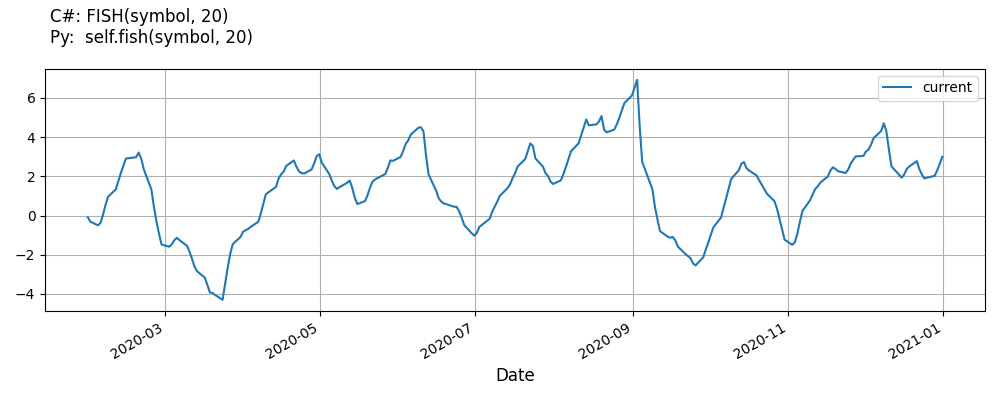Supported Indicators
Fisher Transform
Introduction
The Fisher transform is a mathematical process which is used to convert any data set to a modified data set whose Probability Distribution Function is approximately Gaussian. Once the Fisher transform is computed, the transformed data can then be analyzed in terms of it's deviation from the mean. The equation is y = .5 * ln [ 1 + x / 1 - x ] where x is the input y is the output ln is the natural logarithm The Fisher transform has much sharper turning points than other indicators such as MACD For more info, read chapter 1 of Cybernetic Analysis for Stocks and Futures by John F. Ehlers We are implementing the latest version of this indicator found at Fig. 4 of http://www.mesasoftware.com/papers/UsingTheFisherTransform.pdf
To view the implementation of this indicator, see the LEAN GitHub repository.
Using FISH Indicator
To create an automatic indicator for FisherTransform, call the FISHfish helper method from the QCAlgorithm class. The FISHfish method creates a FisherTransform object, hooks it up for automatic updates, and returns it so you can used it in your algorithm. In most cases, you should call the helper method in the Initializeinitialize method.
public class FisherTransformAlgorithm : QCAlgorithm
{
private Symbol _symbol;
private FisherTransform _fish;
public override void Initialize()
{
_symbol = AddEquity("SPY", Resolution.Daily).Symbol;
_fish = FISH(_symbol, 20);
}
public override void OnData(Slice data)
{
if (_fish.IsReady)
{
// The current value of _fish is represented by itself (_fish)
// or _fish.Current.Value
Plot("FisherTransform", "fish", _fish);
}
}
} class FisherTransformAlgorithm(QCAlgorithm):
def initialize(self) -> None:
self._symbol = self.add_equity("SPY", Resolution.DAILY).symbol
self._fish = self.fish(self._symbol, 20)
def on_data(self, slice: Slice) -> None:
if self._fish.is_ready:
# The current value of self._fish is represented by self._fish.current.value
self.plot("FisherTransform", "fish", self._fish.current.value)For more information about this method, see the QCAlgorithm classQCAlgorithm class.
You can manually create a FisherTransform indicator, so it doesn't automatically update. Manual indicators let you update their values with any data you choose.
Updating your indicator manually enables you to control when the indicator is updated and what data you use to update it. To manually update the indicator, call the Updateupdate method. The indicator will only be ready after you prime it with enough data.
public class FisherTransformAlgorithm : QCAlgorithm
{
private Symbol _symbol;
private FisherTransform _fishertransform;
public override void Initialize()
{
_symbol = AddEquity("SPY", Resolution.Daily).Symbol;
_fishertransform = new FisherTransform(20);
}
public override void OnData(Slice data)
{
if (data.Bars.TryGetValue(_symbol, out var bar))
_fishertransform.Update(bar);
if (_fishertransform.IsReady)
{
// The current value of _fishertransform is represented by itself (_fishertransform)
// or _fishertransform.Current.Value
Plot("FisherTransform", "fishertransform", _fishertransform);
}
}
} class FisherTransformAlgorithm(QCAlgorithm):
def initialize(self) -> None:
self._symbol = self.add_equity("SPY", Resolution.DAILY).symbol
self._fishertransform = FisherTransform(20)
def on_data(self, slice: Slice) -> None:
bar = slice.bars.get(self._symbol)
if bar:
self._fishertransform.update(bar)
if self._fishertransform.is_ready:
# The current value of self._fishertransform is represented by self._fishertransform.current.value
self.plot("FisherTransform", "fishertransform", self._fishertransform.current.value)For more information about this indicator, see its referencereference.
Indicator History
To get the historical data of the FisherTransform indicator, call the IndicatorHistoryself.indicator_history method. This method resets your indicator, makes a history request, and updates the indicator with the historical data. Just like with regular history requests, the IndicatorHistoryindicator_history method supports time periods based on a trailing number of bars, a trailing period of time, or a defined period of time. If you don't provide a resolution argument, it defaults to match the resolution of the security subscription.
public class FisherTransformAlgorithm : QCAlgorithm
{
private Symbol _symbol;
private FisherTransform _fish;
public override void Initialize()
{
_symbol = AddEquity("SPY", Resolution.Daily).Symbol;
_fish = FISH(_symbol, 20);
var indicatorHistory = IndicatorHistory(_fish, _symbol, 100, Resolution.Minute);
var timeSpanIndicatorHistory = IndicatorHistory(_fish, _symbol, TimeSpan.FromDays(10), Resolution.Minute);
var timePeriodIndicatorHistory = IndicatorHistory(_fish, _symbol, new DateTime(2024, 7, 1), new DateTime(2024, 7, 5), Resolution.Minute);
}
} class FisherTransformAlgorithm(QCAlgorithm):
def initialize(self) -> None:
self._symbol = self.add_equity("SPY", Resolution.DAILY).symbol
self._fish = self.fish(self._symbol, 20)
indicator_history = self.indicator_history(self._fish, self._symbol, 100, Resolution.MINUTE)
timedelta_indicator_history = self.indicator_history(self._fish, self._symbol, timedelta(days=10), Resolution.MINUTE)
time_period_indicator_history = self.indicator_history(self._fish, self._symbol, datetime(2024, 7, 1), datetime(2024, 7, 5), Resolution.MINUTE)
